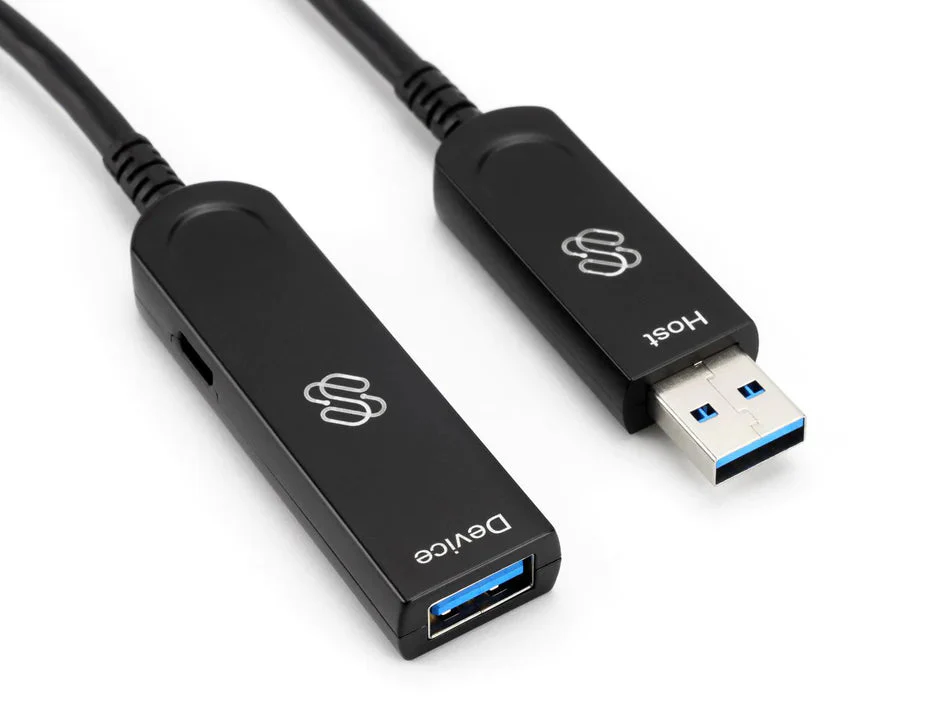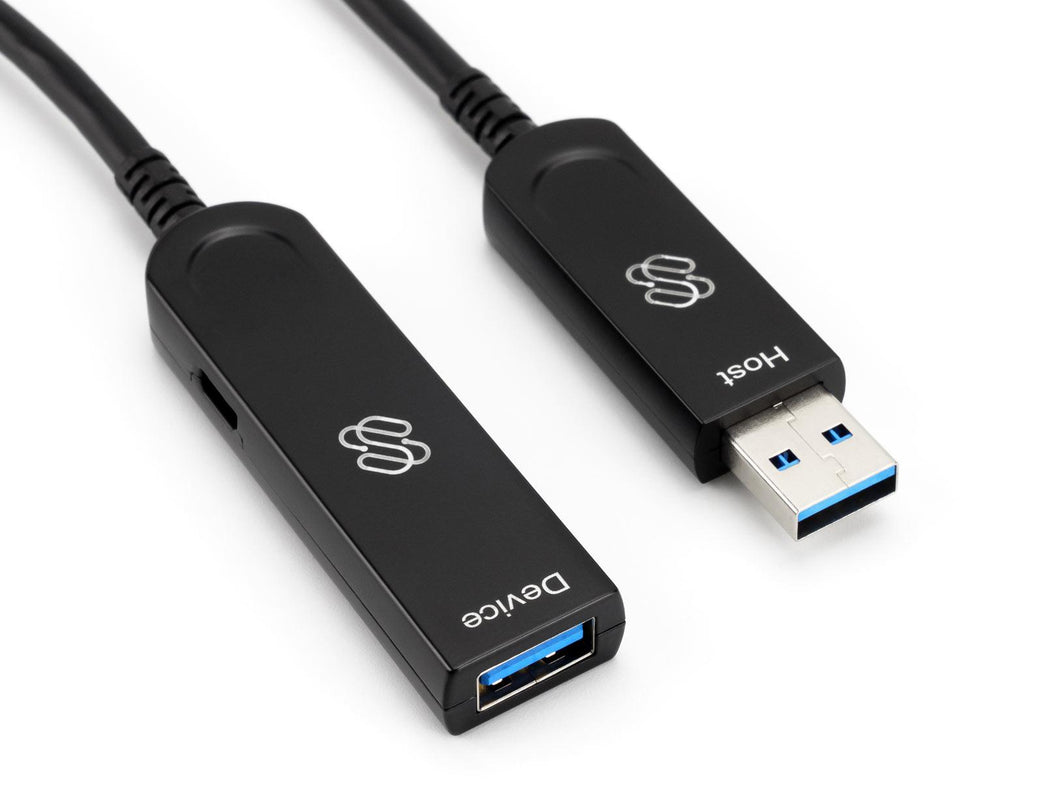
USB 101 - Understanding USB 2.0, 3.0, and USB C
USB (Universal Serial Bus) is a very common data port that is used for a very wide range of peripherals. Some of the supported devices include external storage devices, webcams, printers, scanners input devices like keyboards and mice, and much more.
There are many different common connections used for USB devices, but other than being physically shaped different they all generally provide the same function. USB is much faster than previous, commonly used data ports. Another benefit of USB is that it is able to supply power at 5V DC and 500mA. This allows the USB port to power low-power devices so that you don't have to plug the device into any other power source.
Detailed Specifications:
There are different revisions of the USB spec. The different versions primarily change the supported speeds of the data connection.
Here are the different speeds:
- Low Speed (USB 1.0) - 1.5Mbps
- Full Speed (USB 1.1) - 12Mbps
- High Speed (USB 2.0) - 480Mbps
- Super Speed (USB 3.0) - 5000Mbps
- Super Speed (USB 3.1 Gen 1) - 5Gbps
- Super Speed+ (USB 3.2 Gen 2) - 10Gbps
- Super Speed (USB 3.2 Gen 2x2) - 20Gbps
- USB4 (USB 4 Gen 2x2) - 20Gbps
- USB4 (USB 4 Gen 3x2) - 40Gbps
USB supports a maximum standard cable length of 16 feet. Using passive USB cables longer than this can result in improper function of the USB device. You can get around this problem by using active USB extension cables. These cables have repeaters in them that allow the signal to be repeated to longer distances.
Each USB port can only physically connect to one device. The design of the system, however, allows you to use a USB hub to split that one USB port into several, allowing you to connect many USB devices to a single port. This creates the ability to easily expand the number of USB devices can be connected to a single computer.
Various connectors:
There are several different USB connector types. USB A is the connection found on computers. USB B and mini-B are the most common connectors found on USB devices.
USB stands for Universal Serial Bus, which you probably already knew. You probably already know a lot about USB, being that it is now the most popular data connection for typical consumer end computers.
Brief History
USB was originally designed to replace the motley assortment of cables coming out of the backs of personal computers with their big inconvenient connectors which were USB's predecessors: parallel and serial connections. USB 1.0 was introduced in 1995 but wasn't standardized in computers until 1998 when Apple Computers came out with the iMac G3. USB 1.1 was soon developed after that to help solve problems with the initial USB adoption process.
Later, large companies like Intel, HP, Lucent, Microsoft, etc. decided to join forces and develop a higher-speed USB standard. Improving upon USB 1.1's "Full Speed" of 12 Mbit/s, USB 2.0 to this day supports a max transfer rate of 480 Mbit/s.
Future
USB 3.0 was demonstrated in 2007, and has increased USB 2.0's maximum transfer rates by 10 times, supporting 4.8 Gbit/s (which translates to roughly 600 Megabytes per second). USB 3.0 is just now becoming available in consumer products, and will become the standard in the future.
USB Limitations
Perhaps one of USB's biggest limitations is its distance limitations. USB only extends across 16 feet of typical USB cable. Although you'd probably be able to get more distance, the further you go the more likely you will begin to experience slower transfer rates because of corruptions in the file packets, until entire files are not able to transfer any longer.
Many companies have created ways to overcome this set-back with Active Extender cables, which have an active USB booster chip built-in. If you're needing to go further than the distance these booster cables will give you, try the Light-Link USB, USB 3.0 over Fiber cable, which is available in lengths up to 100 ft.
Amazing USB Feats of Strength
USB has come a long way and has truly become quite Universal, handling more types of connections than the original creators might have imagined:
- USB to Serial and USB to Parallel: Perhaps the first USB adapters conceived since USB was devised to replace the old serial and parallel connections.
- USB to GPIB: Specialized automated industrial and commercial equipment use the GPIB (General Purpose Interface Bus) to communicate and to be controlled by a host computer. One popular use for a GPIB to USB controller is when you want an oscillator to be able to control and print off a USB printer. Use your modern USB connection to control your GPIB machines with this cost effective adapter.
- USB to DVI: Probably one of the more impressive uses of USB, this one allows you to use a USB port as a video port.
- USB to VGA: Like the USB to DVI, this one allows you to use a USB port as a video port.
- USB to HDMI: This amazing device allows you to send your computer’s A/V signal through HDMI to your HDTV.
- USB to Bluetooth: This is a pretty cool way to free yourself of wires, especially if you already have bluetooth devices, like a bluetooth mouse, or a phone with bluetooth on it.
- USB Video Capture Device: Another impressive feat, this device allows you to digitally record video from an HDMI source, such as a camera, to USB and your computer.
- USB to Ethernet: If you want to get a computer on a wired network and you don't have an ethernet port, you can use your USB port with this adapter.
- USB Wifi Adapter: In order for a computer to be on a wireless network, they have to either have a wireless antenna built in, or use an external antenna like this one that connects via USB.
- USB to Expresscard and USB to PCMCIA: Expresscard and PCMCIA are the most common slots in laptops and many manufacturers make cards for these slots for many applications. These USB adapters allow you to add expresscards or PCMCIA cards to a computer that doesn't have these slots available. This adapter comes in extra handy for 3G data cards given to you by your cell phone provider to get internet almost anywhere.
USB 3.0
About Mbit/s
Mbit/s, or megabit per second is not the same as megabyte per second. There are 8 bits in a byte. This means that 480 megabits per second transfer speed is equivalent to 60 megabytes per second.
USB 3.0 Backwards compatibility and construction
USB 3.0 first of all will be fully compatible (or "backwards compatible") with past versions of USB. The actual physical shape of the USB interface remains unchanged, so you can plug any version of USB into any USB port. Of course if you want to take advantage of new USB 3.0 speeds, your device(s) and cable(s) will have to support USB 3.0. Mixing and matching cables and devices of different USB iterations will not hurt anything.
The USB 3.0 interface itself appears the same as USB 2.0 when you just glance at it, but it in fact includes 5 more pins than the USB 2.0. USB 2.0 has always had 4 pins: 2 for data transfer, one for power, and one for grounding. USB 3.0 introduces 5 new pins that sit in a location that can be accessed by USB 3.0 cables and ports, but can be easily ignored by older USB interfaces when plugged in. With the extra pins, the USB 3.0 cable is noticeably thicker.
Four of the five new pins are dedicated to transferring data up and down stream. This is new for USB, since with USB 2.0 the 2 data transferring lines could only transfer data up or down at any given time. Simultaneous up/down transfer is a huge new improvement for USB 3.0.
Speed: USB 3.0 maximum speed is 4.8 Gbit/s
USB 3.0 increased the USB 2.0 max data rate ten-fold to 4.8 Gbit/s (or 600 mega bytes per second). Looking at this on paper, this is super fast. Imagine being able to transfer your entire library of music of 22.5 Gigs (well, that's mine) in a little less than a minute. I actually transferred all of my music from my mac back to my old mac and it probably took around 15 minutes.
Let's be realistic though
Many critics of USB 3.0 (and USB in general in most cases) point out that these are all theoretical data transfer rate specs. It is true that USB 2.0 has rarely (if ever) reached its 480 mbps potential. Many are waiting to see what it really does. The ability to transfer up and down simultaneously makes the 4.8 Gbit/s potential a little more reachable. Although data rates will likely greatly improve, many still doubt we will see 4.8 Gbit speeds.
Another barrier in the way of freely flowing data rates is hard drive read/write speeds. There aren't any traditional hard drives available that can read/write at these speeds, so it would seem that the 4.8 Gbit speed wouldn't work out anyway. Newer solid state drives will definitely benefit greatly, however. Compared to traditional drives that contain a physical spinning disk that can only spin at a finite speed, solid state drives (such as flash drives) don't rely on physical moving parts to work.
Real-time tools to benefit greatly
Firewire, an interface that is losing ground in this seemingly never-ending format war, still finds comfortable niches in industries that require real-time transfers without any delay. Industries such as music, video, and other miscellaneous media use firewire 400 and firewire 800 to connect I/O instruments that transfer massive amounts of data in real time. A good example is a mixer interface. No one in their right mind would buy a USB mixer with 16 channels or more. Firewire has always performed the best in this application. USB 3.0 might replace firewire completely for real-time I/O applications.
More Efficient Power... and Just More Power
USB 3.0 has increased its current from 100 milliamps to 900 milliamps meaning you can charge and power bigger devices, and/or more devices at once. Not only is there more power, but it's smarter power. When battery powered devices that aren't being charged are connected to a computer, instead of draining power by the host attempting to find a signal, USB 3.0 uses a signal to announce when data transfer is activated.
Benefits of USB 3.0
USB 3.0 is over twice as fast as USB 2.0. This added speed, combined with the other new features offered by USB 3.0 is making a huge difference in the world of USB peripherals, including cameras, external hard drives, and more. Find out how USB 3.0 is changing the way we look at USB.
What is USB?
USB (Universal Serial Bus) is a universal connection used to connect electronic devices (like digital cameras, external hard drives, printers, etc.) to a computer. The idea was to replace all of the different connection types needed for different devices with one easy to use connector.
We take for granted how much easier things are now that we have USB. For one thing, it was designed to work over all of the major operating systems. It’s also “hot-swappable,” meaning that you can add or remove a USB device without restarting the computer. Back in the day you would have to restart your computer in order for it to recognize your device. And finally, USB is “plug-and-play,” meaning that your computer will automatically recognize the device and install the right drivers for you.
All of these things seem commonplace right now, but back in the 90’s, when USB was invented, these were revolutionary advances. And USB hasn’t stopped being innovative. There have been three different versions of USB released over the years, each one becoming increasingly faster. The first USB drives only supported speeds of up to 11 Mbps, which didn’t give it much capability. Later USB 2.0 came out, offering speeds of up to 480 Mbps. This was a huge step forward and allowed external hard drives and other mass storage devices to be used with USB. Now SuperSpeed USB 3.0 is out, and it is once again changing everything.
What’s so Great About USB 3.0?
Every year people seem to have greater demands for transferring larger files at faster speeds. It’s not just companies that need large file backups anymore. With the price of hard drives becoming more and more affordable, many at home now have external hard drives that are 1 terabyte or larger. Not only that, but more people are now able to afford cameras that allow for high quality video and photos, making the files much larger. You need faster transfer rates. SuperSpeed USB 3.0 gives you transfer rates of up to 5 Gbps. That’s ten times faster than USB 2.0. Not only that, its bidirectional, letting you read and write data at the same time. What does that mean for you? It means you can download photos, music, videos, and data faster. But not just faster, ten times faster. And, if you want to upload something on your device, but it’s already downloading something else, you don’t have to wait.
All of that added speed also means that USB Ethernet adapters can now achieve internet speeds of up to 1 Gbps, making them even faster than wireless internet connections.
One more great thing about USB 3.0: It’s much friendlier on the environment and your wallet. USB 3.0 has new capabilities for managing power. These new capabilities allow for any unused devices you may have connected to your computer to enter into sleep mode, lowering your carbon footprint and your utility bills.
If you have some USB 2.0 devices, don’t worry, USB 3.0 is backward compatible, so it will still support all of your USB 2.0 and USB 1.1 devices. Just remember, if you want to achieve USB 3.0 speeds, you’ll need to upgrade your computer with a USB 3.0 host card. You’ll also need to make sure that your device (like your external hard drive) is compatible.


